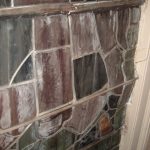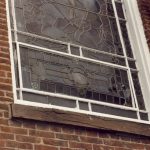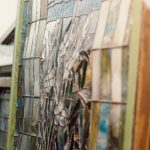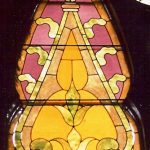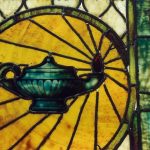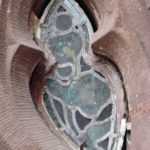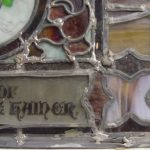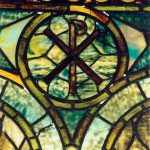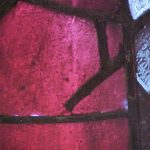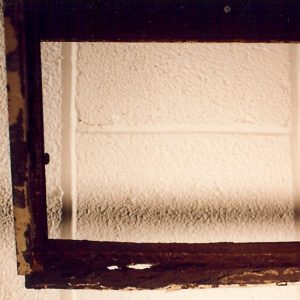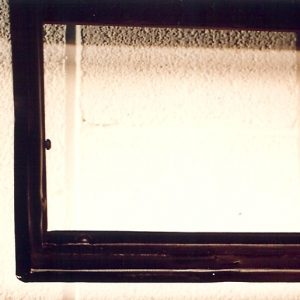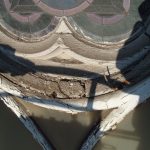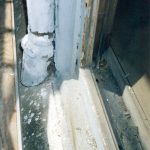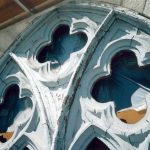DO YOUR WINDOWS NEED ATTENTION?
DO YOU KNOW WHAT TO LOOK FOR?
The following descriptions and photos of a few common conditions that occur in older stained glass windows will help you recognize the early warning signs of deterioration, before irreparable damage is done. We believe that knowing when to call is almost as important as knowing whom to call.
THE THREE B’s
Are your windows bowing, buckling or bulging? This is known as planar deflection and is an indication that the lead channel, which is the primary structural support system of the window, is deteriorating. Depending upon its alloy composition, lead has a service life of 75 to 100 years. (For further information, read the Article “ANALYSIS AND COMPARISON OF OLD AND NEW LEAD CAME” located in our Library.) If your windows are nearing this age, it is time to call and request a window survey and condition report. If the deflection is allowed to progress, the window will migrate downward, tear away from the support bars and, eventually glass will break as a result of this stress. All three of the photographs below show windows that have been allowed to deteriorate to the point of structural failure.
DAYLIGHT LEAKS
An easy condition to spot is the appearance of light leaks between the glass and the lead. This is an indication that the lead has aged and stretched over time and is allowing the glass to displace from the lead channel. This condition can quickly result in the loss of the most important part of the window – the stained glass. It can also endanger people walking or sitting near the window. A good rule of thumb is that if the edge of the glass is visible, the window needs attention immediately.
IMPROPER TREATMENTS AND UNQUALIFIED PRACTITIONERS
When a stained glass window is between 75 and 100 years old, it is at the point of requiring restoration by complete releading. Because releading is an expensive proposition, many studios offer “alternative” treatments such as recementing or cleaning in place, flattening or reducing bulges, adding support bars, installing exterior protective glazing, applying fake leads over cracks, and other so-called repair or stabilization programs. These treatments will only serve to damage your windows, cosmetically or structurally. In a very short time, you will then be faced with spending additional money on a proper restoration. Honest and qualified craftsmen do not propose such short-term wasteful remedies. None of these short-term cosmetics deals with the inevitable fact that, after 75 to 100 years, the lead requires replacement. Complete lead replacement is the only method by which you can successfully resolve all of the aging problems and conditions that occur in a stained glass window. It is the only responsible remedy when treating anything other than vandalism repair or spot damage from storms, etc. When the time comes to consider restoration of your stained glass windows, be diligent in choosing a qualified and responsible restoration studio in order to be assured of the highest quality craftsmanship. This effort will result in another 75 to 100 years of maintenance-free service life for your stained glass windows.
Although complete lead replacement was properly prescribed for the center window, the restoration studio was not closely examined. The poor quality of this work is hard to believe. Lead miters are non-existent, the soldering is not completed, holes from broken glass are left gaping, and it appears that no glass was cleaned. This window was severely damaged by a misguided, unskilled craftsman.
INOPERABLE VENTILATORS
The ventilator is both a structural and mechanical part of a window, and should not be overlooked in a thorough stained glass analysis. There are several common causes for poorly operating vents: build up of many layers of paint, water intrusion around the frame itself, swelling of the wood frame which forces the perimeter vent rail out of square, and sagging of the top outer vent frame from the weight of the window above, thus pinching the inner vent frame, rendering it inoperable. A project that does not include proper ventilator restoration is not complete, and will lead to additional expenditures in the near future when poorly operating ventilators cause damage to the recently restored stained glass.
DETERIORATING FRAMES
A contributor to stress on stained glass windows is an aging and deteriorating frame. Wood frames are particularly susceptible to a variety of pressures: extreme changes in temperature, moisture intrusion, delamination, infrequent maintenance and poor original construction. The photos below show 100 year old frames that are failing. Weather and age are causing wood members to separate. This structural failure effectively removes the support for the stained glass, allowing the glass to bow and bulge. If the deterioration goes unchecked, lead and solder joints will crack, glass will break, and with increased pressure from the sagging frame, the stained glass panel will dislodge from its location.
